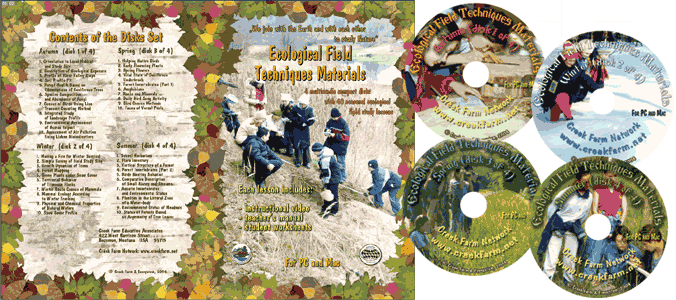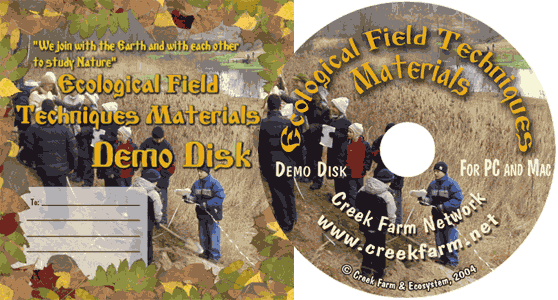|
| Our Field Ecology Center published more than
180 methodical materials for nature studies. Some of them are in English: |
|
|
|
Assessment of Air Pollution by Lichen Indication Method
© Alexsander S. Bogolyubov,
Michael V. Kravchenko, Russia, 2001
© Michael J. Brody, USA,
2003
 This manual contains procedures for the
application of bioindication research using lichens for the assessment of environmental
conditions. The focus is on methods of quantitative evaluation of lichen
species in biological monitoring based on the use of poleotolerance classes and
lichen bioindication indexes. This manual contains procedures for the
application of bioindication research using lichens for the assessment of environmental
conditions. The focus is on methods of quantitative evaluation of lichen
species in biological monitoring based on the use of poleotolerance classes and
lichen bioindication indexes.
This field study has instructional video
featuring real students conducting the ecological field techniques in nature. Each video
illustrates the primary instructional outcomes and the major steps in accomplishing the
task including reporting the results.
Introduction
The response of biological objects to pollutants is significant for investigations of
environmental pollution caused by industrial means. A system of observations of the
response of biological objects to the impact of pollutants is called biological
monitoring.
Biological monitoring includes observation, assessment and forecast of changes in the
state of ecosystems and their elements caused by anthropogenic factors.
Lichens have been chosen as one of the main objects of global biological
monitoring. Lichens represent a peculiar group of spore plants consisting of two
components Ц a fungus and a single-celled or, rarely, filamentous algae,
which live together and function as one organism. The fungus performs the functions of
reproduction and feeding at the substratum, whereas the algae photosynthesize.
Lichens are very sensitive to nature and composition of the substratum; their
growth is dependent on microclimatic conditions and composition of air.
Due to the extraordinary longevity of lichens, they can be used for dating the age of
various objects over the range of several decades to thousands of years, based on
measurements of their thallus.
Lichens were chosen as an object of global monitoring due to the fact that they are
widespread on earth and their response to external influence is very strong, whereas their
own variability is small and extremely slow compared to other organisms.
Epiphytic lichens (or epiphytes), i.e. lichens growing on bark of trees, are
characterized with the most sensitivity among all ecological groups of lichens. Study of
these species in large cities of the world revealed a number of general patterns: the more
industrialized the city is, the fewer species of lichens are found; the less the total
area of the tree trunk is covered with lichens, the lower the vitality of the lichens.
It has been discovered that when the level of air pollution increases, first fruticose
lichens disappear, then foliaceous lichens, and the last ones to disappear
are crustose (cork-forming) forms of lichens. Composition of lichen flora in
different areas of a city (in the center, in industrialized districts, in parks and in the
outlying districts) turned out to vary so great that researchers began to use lichens as
indicators of air pollution.
A Swedish scientist, R.Sernander, conducted one of the first studies in this field
in 1926. He pointed out a Уlichen desertФ in Stockholm (a center of the city and
industrialized areas with high level of air pollution) where lichens were almost
completely absent. He also noted a Уcompetition zoneФ (districts of the city with
average level of air pollution) where the number of lichens was poor, and a Уnormal
zoneФ (outlying districts of the city) where many species of lichens were found.
Recently it was shown that among all components of polluted air, sulfur dioxide
(SO2) has the strongest negative influence on lichens. It was
experimentally proven that a concentration of sulfur dioxide equal to 0.03 Ц 0.1 mg/m3
(30-100 microgram/cubic meter) had an impact on many species of lichens. At that
concentration, brown spots appear in chloroplasts of alga cells and
degradation of chlorophyll begins. A concentration of sulfur dioxide equal to 0.5mg/ cubic
meter is harmful (even destructive) for all lichen species found in natural landscapes.
There is a group of poleotolerant species (resistant to pollution), that can
exist in rather polluted air.
In addition to sulfur dioxide, other pollutants including nitrogen oxides (NO,
NO2), carbon oxides (CO, CO2) and fluorine compounds also have an
adverse effect on lichens. Moreover, microclimatic conditions in cities have
changed greatly from their natural origins: cities are УdrierФ in cities, compared to
natural landscapes (approximately 5% drier) and 1-3% warmer. Cities are also characterized
by poorer natural illumination.
With this information in mind, lichens serve as integral indicators of the state of the
environment. The presence of Lichens in general indicates that abiotic
factors are favorable for life.
Most chemical compounds, having a negative impact on the flora of lichens, represent
the main chemical elements and substances found in the emissions of most industrial
objects. This information allows us to use lichens as indicators of the anthropogenic
load.
All the above-mentioned factors helped to determine the application of lichens and
lichen bioindication in the system of global environmental monitoring. The present lesson
is also based on attempts to use lichens as bioindicators of the state of environment.
This lesson is aimed at assessment of spatial differences in air pollution based on the
use of lichens.
The following items will be required for the lesson: transparent overlay grid,
measuring tapes with millimeter points (1 meter long) and a compass.
General procedure of the research
This research, like many other studies devoted to environmental monitoring, is rather
difficult and has many different aspects. In this section, we will provide a general
description of the research as a whole, and then the following sections will focus on specific
rules of lichenoindication studies, techniques of material collection, and methods
of...
This was only the first page from the manual and its full version you can see in the
Ecological Field Studies Techniques Video 4CD Set:
It is possible to purchase the complete set of 40 seasonal Ecological Field
Studies Techniques Video (in mpg format) in an attractive 4 compact disk set.
These compact disks are compatible with Mac and PC computers.
The videos are suitable for individual student or whole class instruction. To purchase the complete 4CD set
write to ecosystema1994@yandex.ru in a free form.

Ecological Field Studies Demo Disk:
We also have a free and interesting demonstration disk that explains our ecological field studies approach.
The demo disk has short excerpts from all the seasonal field study videos as well as sample text from all the teacher manuals.
The disk has an entertaining automatic walk through which describes the field study approach and explains how field studies meet education standards.
You can also download the Demo Disc from ecosystema.ru/eng/eftm/CD_Demo.iso.
This is a virtual hybrid (for PC and Mac computers) CD-ROM image (one 563 Mb file "CD_Demo.iso").
You can write this image to the CD and use it in your computer in ordinary way.
You also can use emulator software of virtual CD-ROM drive to play the disk directly from your hard disk.

|







